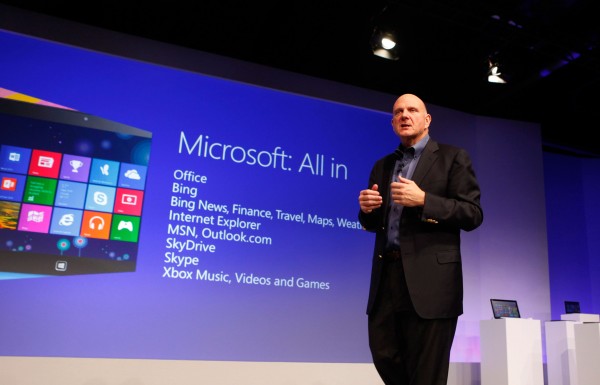Why are Windows 8 sales so good when PC shipments are so bad?

All signs pointed to another disappointing quarter for Microsoft's Windows division. But, instead, with fiscal second-quarter results announced today, revenue rose 24 percent year over year. Meanwhile, PC shipments are down 6.4 percent during same time period, according to IDC, which doesn't seemingly reconcile with Windows OEM revenue rising 17 percent. What's up with that?
There is sense behind the numbers, which forebode potential trouble ahead the next couple quarters, unless PC shipments pick up or Microsoft hits a big home run with Surface Pro, which goes on sale February 9. Simply stated: The company got big lift by selling cheap Windows Pro upgrades, something that ends January 31. OEM increase is byproduct of PC makers stocking the shelves with new models. Neither is sustainable, raising question: Will Windows 8 be a one-hit wonder? Meaning: One quarter of sales greatness?
Microsoft reported Windows & Windows Live revenue of $5.88 billion, which benefited from a $622 million deferral. Year over year growth was 24 percent with the deferral, 11 percent without it. From real-world sales then, that's $5.26 billion. Biggest sales growth came from outside the typical PC ecosystem. "Non-OEM revenue grew over 40 percent, driven by Windows 8 upgrades, sales of Surface and double-digit growth in volume licensing", Chris Suh, head of Microsoft investor relations, says, during today's earnings conference call.
Grand Opening Sale
Let's focus on those upgrades first. There are three kinds, all to Windows 8 Pro:
- $14.99 -- for people buying Windows 7 PCs from June 2 to January 31
- $39.99 -- online, direct-from-Microsoft
- $69.99 -- retail packaging with DVD
The pricing is the lowest Microsoft has ever offered for the Professional product. Heck, the non-pro version isn't even yet available for sale, outside the OEM version. The lesser Windows 8 goes on sale next week.
Come February, Windows 8 pricing jacks up big time, presenting a hefty barrier to retail sales, which tend to be strongest during the first few months anyway. But I suggest, given Windows great quarter set against PC declines, those discount upgrades matter big time, and last day is January 31.
A day later, Windows Pro upgrade will sell for $199.99, a 400-percent increase over the $39.99 deal and 186 percent from the other one. I can easily imagine these perceived price increases suddenly stopping most upgrades. I say perceived since actual Windows 8 and Pro pricing is same as the comparable previous versions. What's different is how little pay now.
Question: How does the revenue distribute? In past quarters, Microsoft execs said that OEM sales account for 75 percent of Windows revenue. I must assume higher for the holiday quarter, given sluggish PC sales and low-cost retail upgrades. Microsoft boasts 60 million Windows 8 licenses sold. If you divide that number into $5.26 billion, you get average selling price of $87.64.
But, technically, Microsoft started selling Windows 8 to some businesses before the quarter started. So while the company would have you believe 60 million since October, the sales period is more like August. Something else: Some smidgen of the Windows & Windows Live division revenue comes from other stuff. I started to cut the numbers various ways but decided it's unnecessary this late in the day to make the point -- that prices go up as much as 400 percent at retail, which is sure to slow license sales.
Slam the Brakes
But brakes don't just stop there. Calendar first quarter is typically slowest for PC sales. For Microsoft what matters is new shipments into the channel, because that's when license revenue goes on the books. Many years ago, different accounting meant Microsoft didn't get paid until the PC sold. Now the money comes up front, but not if OEMs don't build systems to ship.
The "Who Wants to be a Millionaire?" question: How much PC inventory remains unsold from the holidays? If channels are full, as I expect they are, Microsoft sells fewer Windows 8 licenses during first quarter.
You see where this is going right?
There's still a month of cheap Windows 8 upgrades on the books and, honestly, Microsoft should jack up prices to normal levels. If retail sales will fall off anyway, maximizing margins is the better approach. Timing is the question. Is Microsoft acting too soon, or just right?
The answer to the question means much. Microsoft is about to launch Office 2013, and there is a longstanding pattern of at least some sales tie to Windows. Many businesses will upgrade Office and OS at the same time. Some consumers, too. That could be good for PC sales, but retail is opportunity. If Mr. Small Business is going to get Office 2013 and Windows 8 Pro anyway, let him pay 200 bucks instead of $40 or $70. From that perspective, Microsoft could make more from the Office glow by ditching cheap Windows upgrades. Surely some bean counter inside the company with access to numbers I don't has crunched them.
Then there is Surface Pro, which if successful could open exciting new revenue source for Microsoft.
So the answer to the question is low-cost upgrades and PC channel stocking. As for the one-hit wonder, there's still chance that calendar first quarter will be a reprise. Not a No. 1 smash, perhaps, but at least placing on the charts.
